 . . .
. . .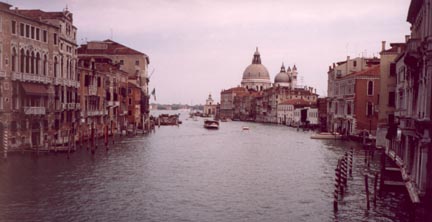
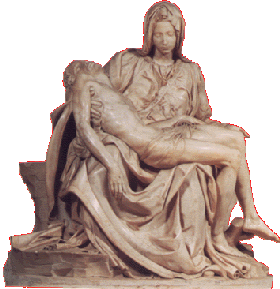
Italy is a country with much to see. It seems everywhere you go there is very old and differet things to see. I traveled from the waterway streets of Venice to the steps of Lamborghini and then onto the grandest capital in all of Europe, Rome. Rome itself was very impressive, with many of the old and newer architecture done with the classic Roman style and gradeur. Statues and sculpture by Michelangelo are everywhere. His work and the work of Raphael adorn much of the Vatican. The arcitectural and sculptural rivalry of Borromini and Bernini are evident throughout this city. The countryside is quite and warm. To the right is the famous Pieta by Michelango, which is now housed behind protective glass in the Vatican. Rome is also a busy city with cars and moped everywhere. You must quickly learn to "cross the street like a Roman" with no fear or you will be forever waiting for the traffic to stop. The neat thing is that you don't have to go very far to find a quite part of the city with beautiful fountains and a quite spot to sit and ponder the wonders that are all around. Ancient structures are everywhere and it seems everytime they try and dig into the ground another ancient ruin is uncovered. You can walk the same steps as Ceasar and hear the tales of treachery and deceit from centuries ago. All in all, I enjoyed my visit there and would definetly suggest it as a stop on any European tour. Below is a small photo gallery of many of the sights I saw on my travel through this unique country.
 . . .
. . .
One thing I found out quite quickly is that is is quite hard to walk around in Venice. Every time you try and walk somewhere you keep running into water, and no there are no sidewalks along the waterways or in front of many of the buildings. "Streets" that are paves are little more than narrow walkways. I guess that's why you are supposed to take the boats around. I did however manage to walk from the train station to the far side of the city. I had dinner over there and then took a boat all the way back to the train terminal. I was only in Venice for a day so I did not get to spend too much time there, but it was interesting. Unfortunately many of the old buildings have not been properly maintained and are in dire need of repair, especially on the side of town towards the train station. Above are two pictures of the waterways from the eastern side of town. In the picture on the right you can see how the buildings come right up out of the water with no walkway except for a boat to land.
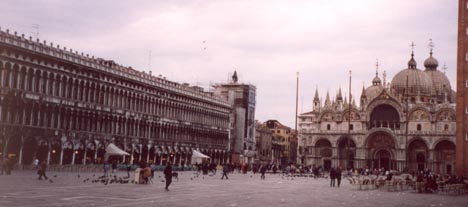 |
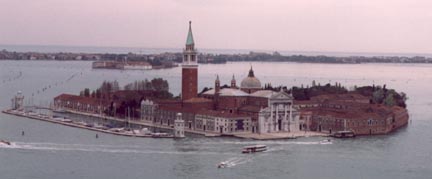 |
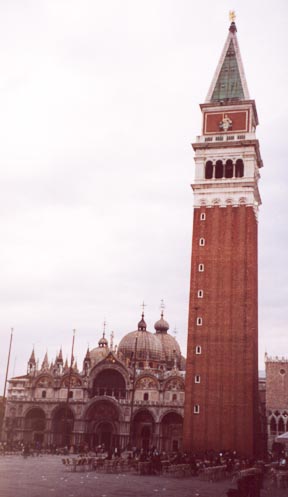
I wandered through the small streets of Venice until I came upon a huge piazza. The piazza was the Piazza San Marco. It is huge and quite a contrast to the crowded packed in style of most of the rest of the city. At the far end of the piazza is the Cathedral of San Marco di Venezia. Although I did not go inside the cathedral, the outside itself is quite an amazing sight. It is an example of Italo- Byzantine architecture, integrating Greek structure and planning with typical Western décor and design elements. It was quite different from any other cathedral I saw in the rest of my travels. The San Marco which can be seen today is actually the third version of the cathedral. The pictures above show the narthex facade. The first burned in 973 and was then rebuilt. It was torn down a century later and the third, and present one, was constructed in 1073. The Campanile lies in front of the cathedral and it was $10 (20,000 lire) to ride to the top. Be careful! My elevator was half way to the top when I heard bells ringing, when we got off the elevator, the bells were about 5 feat overhead and quite loud. The view from the Campanile was probably the best in all of Venice. The picture of the island is from the Campanile, I do not know what island it is but is shows how Venice is set up with small islands on the edge that are full of buildings as well. The only way to reach then is by boat. No cars here! The picture below is of me in the top of the Campanile.
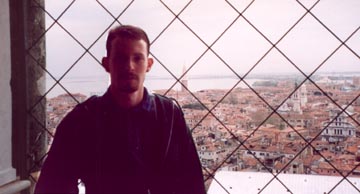
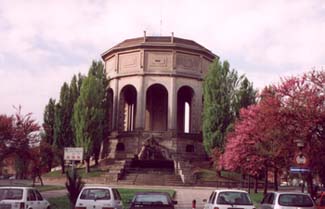 . . . .
. . . .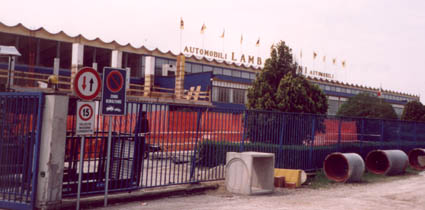
On my way to Rome I tried to see a few things along the way. Above and to the left is a shot from Ferrara. There was a classic car museum there but it was closed on the day I was there so I just wandered around for an hour waiting for the next train. My next stop was Bologna. From there I was going to take a bus to Sant Agata. From there I was going to see if I could get a tour of the Lamborghini factory. Unfortunately they had demolished most of the factory and torn down the museum and were rebuilding everything. They were quite insistant upon no tours. So all I got was the shot of what's left of the front of the factory. Oh well, I guess try again next time....
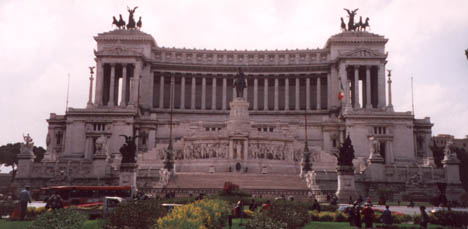 . . . .
. . . .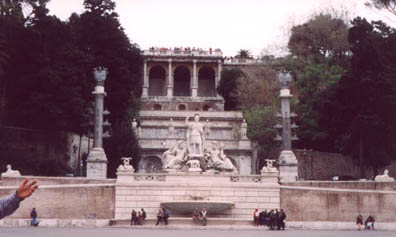
I arrived in Rome on a Friday night and proceeded to the hostel I had reservations at, Gulliver's House. If you are looking for a nice hostel to stay at I recommend the one I stayed at. It was quite clean and easy to find. The hosts there, Simon and Sara were excellent hosts and always willing to help out. Simon sat down one evening and went through a big bucket of Itailian coins with me so I could get a copy of each Italian coin to take with. The price per night was about 30000 L ($15). The phone number there is ++39-064817680. Address is Via Palermo, 36, 00184 Rome, Italy. See the links at the bottom to go to their website. The next day I spent wandering around Rome seeing what I could see. Rome was actually quite easy to get around in if you don't mind walking a bit. The Vatican was about a 20 - 25 minute walk from the hostel and was the farthest thing from there to see. The most impressive structure you see on your first walk in Rome is probably the Monument to Victor Emmanuel, which is above and to the left.. It was designed by architect Giuseppe Sacconi. Behind this monument lies the official church of Rome (it is not the Vatican, since that is separate from Italy altogether) and then strech the ruins of the Forum and the legacy of Ceasar. Above and to the right is a picture from the Piazza del Popolo.
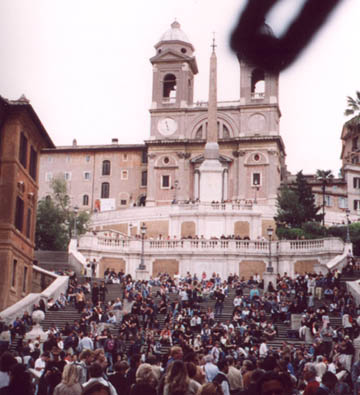 . . . .
. . . .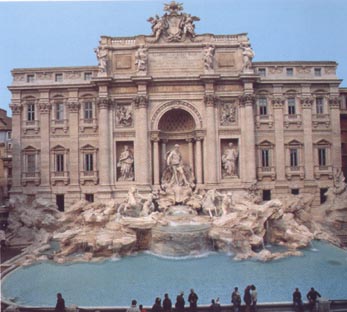
The next night I took a tour with a company called THROUGH ETERNITY, which has walking tours of Rome. See the links section at the bottom to goto their webpage. They has an evening tour of many of the plazas and piazzas of Rome with all of the history that went along with them. The company was run by a group of history students (mostly graduates) from all over, US, Ireland, England...., and they made the Roman cityscape come alive with the stories and struggles of the past. For the evening tour we began at the Spanish Stairs (above left). At the top is a Spanish Church, the Trinita dei Monti, which was a present from Spain. The Spanish stairs always house a large gathering of younger people looking to meet other young people. In this picture it is actually quite empty. Also, excuse the camera strap who also wanted to become part of the picture. At the bottom is Bernini's Fountian of the Barcaccia. The picture on the right is what I feel was the most spectacular fountian in Rome, The Trevi Fountian. Designed by Nicola Salvi, it is enormous and extremely detailed. It recently underwent cleaning and repair so it is even more spectacular now.
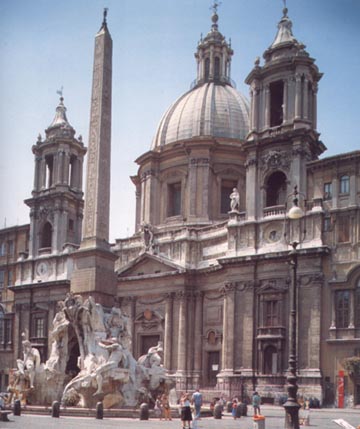 . . . .
. . . .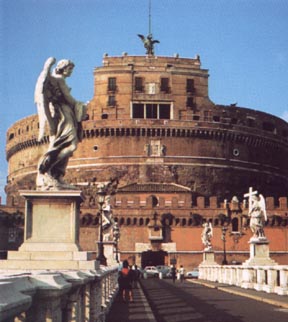
The picture above and to the left show the work of two of the most prominent architects of Rome, Bernini and Borromimi. The Church of Sant`Agnese in Agone was built by Borromini in the middle of the 17th century. Bernini's Fountian of the Rivers sits in front of this church. Our tour guide suggested that the figure facing the church is reeling back in horror afraid that the church is about to fall a on top of him, which can be taken as the architectural rivalry between these two men. On the right is the Castle Sant`Angelo, which served as a fortress for the Popes in the Middle Ages. There is a elevated walkway that runs from the Vatican to this castle for the popes of times past to use as an escape route when invaders threatened them.
 . . . .
. . . .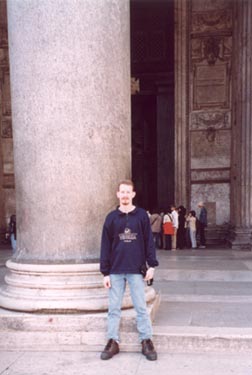
These next two pictures show what is probably the most impressive structure of Ancient Rome, other than the 2000 year old aqueduct that still feeds the city the bulk of its water supply. It is the Pantheon and is a most amazing structure. Transformed to a church, when christianity became the dominant religion, it is a most unique domed structure. It was not until up to about 50 years ago that modern technology was able to build a dome similar to this structure's dome. The part that makes this dome so unique is the fact that it has a large hole in the center. When the structure has enough people in it and the doors are closed the rising heat is enough to keep rain from falling through the hole and thus keeping the inside dry. The pillars in front are also a mystery. They are carved from a single piece of red granite from Egypt. How they were transported and stood up is a mystery. Also the structure that supports the triangular peak is made from wooden timbers preserved with an unknown preservant that has withstood 2000 years and is still structurally sound today. The picture that shows me in front of one of the pillars should give you an idea of the size of these pillars. The dome itself on the inside is so large it is hard to grasp the actual shape and size of it. It is an amazing building and shows the ingenuity of the ancient Romans. The exterior of the building used to be adorned with bronze and marble decoration, as did all of the ancient structures, unfortunalely the christian invaders used these in the construction of churches and cathedrals. It is a shame since I bet it was quite the sight before these were taken.
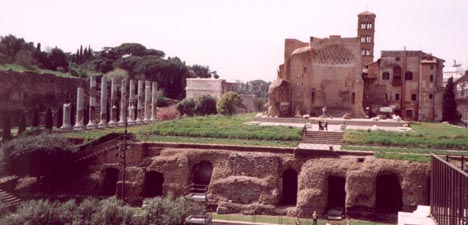 . . . .
. . . .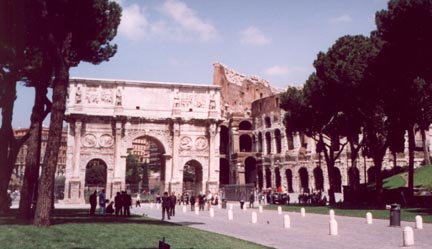
These next pictures are in the area of the Colosseum and the Arch of Constantine, probably the most famous ruin in Rome. the picture on the upper left shows part of the Roman Forum ruins, while the above right is the Arch of Constantine with the Colosseum to the right. The arch seems quite large, until you walk up next to the Colosseum, then it seems small.
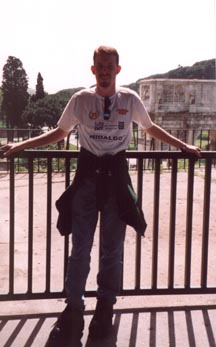 . . . .
. . . .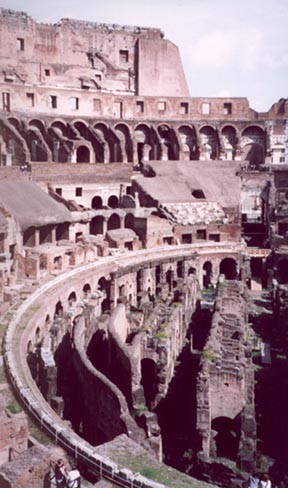
The picture on the above left is of me in the Colosseum with the Arch in the background. The above right is standing on the second level of the Colosseum looking down upon the arena floor. What you see here is what is under the floor which was made of wood. The passageways and such were the "basement" of the Colosseum and was where the doomed and competators were kept until competition. As you go further up you can see some of the seating and viewing area as well. At the highest part you can see how an artificial wall has been built into the Colosseum to keep what is left from falling down.
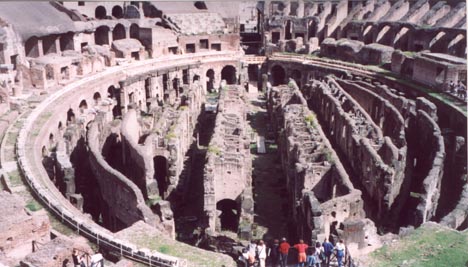 . . . .
. . . .
The above left shows the entire arena floor and the above right shows the best picture I could get of the whole Colosseum. Bring a wide angle lens if you want some nice pictures of this, because its big!
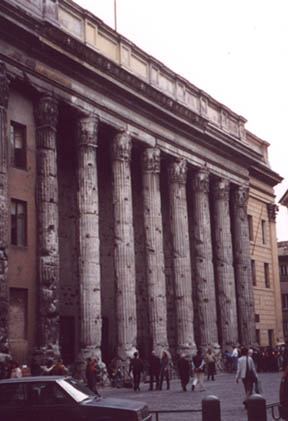 . . . .
. . . .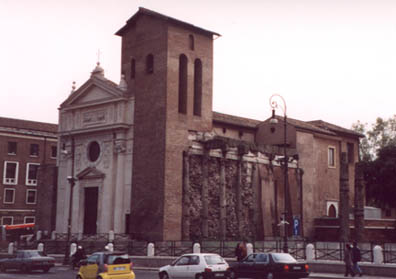
One of the most interesting things in Rome, which is more or less prevalent in all of Europe, is that old structures are reused again and again. Here you can see how old ruins have been built upon and built over. The picture on the left has the ancient pillars running up the sides with people working on computers in their offices inside. The base of the building is actually about 5 feet below the street level since when buildings were torn down they were leveled and then built upon. This is one reason that whenever any type of excavation is done for whatever reason, ruins are always unearthed. The above right is a church that is in a structure that looks as if it was reused multiple times. Quite an interesting concept from the American way of blow it up, tear it down and start over again. Perhaps we could learn something.
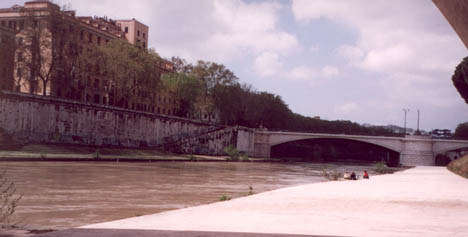
The Tiberis River also flows through rome and gave the opportunity for many spans of intracate bridges to cross it. The center of Rome has some 14 bridges that span this river. This picture shows one typical such bridge. Some are more plain like this one, while others have statues and carvings adorning them.
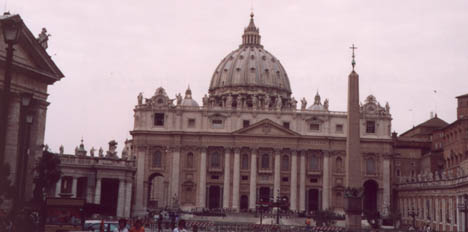 . . . .
. . . .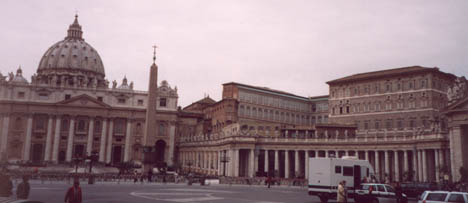
The last stop was the Vatican. I also took a tour with THROUGH ETERNITY for this. On this tour we ran through the Vatican museums and St. Peter's Basilica in 5 1/2 hours. Having a guided tour of this helped to bring to life what we were looking at. I wished I had had one more day to go back through them a second time to take time to look at the magnicifent items in them in more detail. These two pictures above show the front of the Basilica from the Piazza St. Pietro. This piazza is also where the Pope conducts his worship services such as Easter which was the following weekend from when I was there. In the upper right picture there is a building on the right hand side of it. The top two window in the right of this building are the Popes residence. One is his bedroom and the other his study. He can be seen leaning out of one of these windows blessing people occasionally.
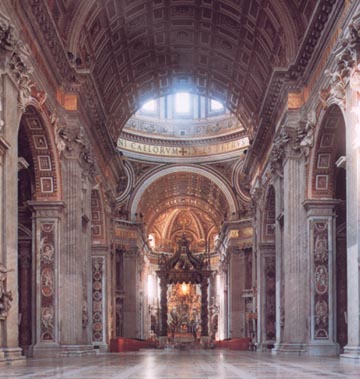 . . . .
. . . .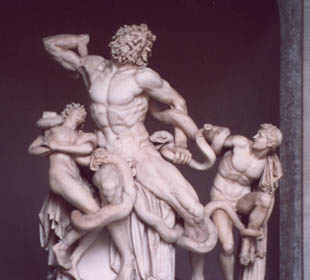
The above left picture is inside the Basilica and can really only be appreciated in size and splendor with a visit to it. The canopy above the main alter is made from bronze taken fron the ancient ruins above and was designed by Bernini. The dome above it is 3 times the height of this canopy. The above left is The Laocoon. It is a Greek sculpture from the 1st century AD, and was found in the excavation of the Domus Aurea. It was admired by many artists including Michelangelo.
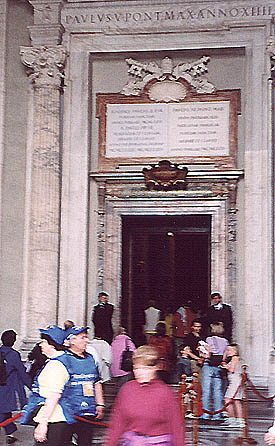
This last picture os of the Holy Door at the Vatican. It was a Holy year when I was there so the Holy Door was open. Walking through this door mean all your sins were forgiven. It is only opened when the Pope declares it a Holy Year. The rest of the time it is sealed up with bricks and mortar. A Holy Year is only decared once every 25 to 30 years.
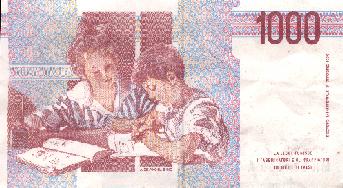
Here is a 1000 Lire bill from Italy. Its worth about $0.50 USD. Change in Italy is virtually useless unless you are tipping someone very little.
This Page was last updated on 17 May 2001.
This page created and maintained by Garrett Robert Herning.